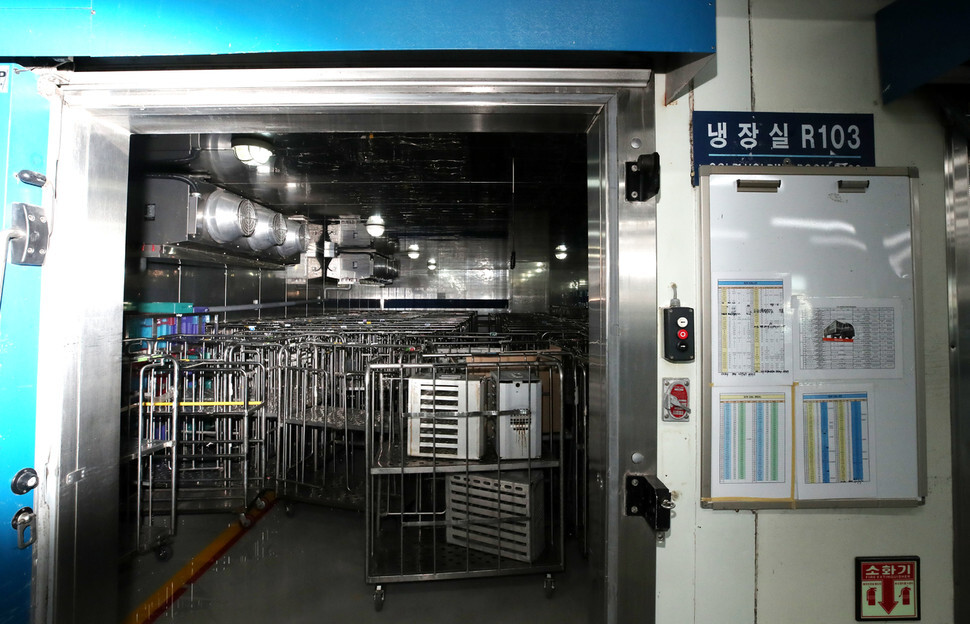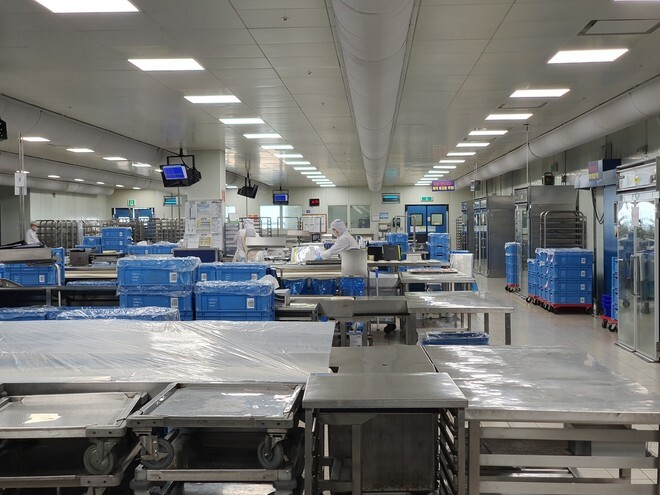hankyoreh
Links to other country sites 다른 나라 사이트 링크
As airlines suffer losses, so do their subcontractors and partners

On the morning of Apr. 2, all was quiet at Korean Air’s airline meal production center, a three-story building near Incheon International Airport, in Incheon’s Jung District.
There were no signs of the usual hustle and bustle of food preparation. The carts used to carry airline meals were stacked and empty; the long line of waiting refrigerated trucks that would have driven those carts to the airplanes was nowhere to be seen. Most of the freezers on the first floor that typically stored airline meals after preparation were marked with notices that said, “not in operation”; a few of them were even being used to store other items.
Air travel has been nearly shut down by the COVID-19 pandemic, threatening the very survival of South Korea’s aviation industry. This center used to produce 72,000 airline meals a day for 30 airlines, including Korean Air, but its output has plummeted since Feb. 3, when COVID-19 began to spread in the country. One month later, its production had dropped below 20,000; more recently, it reached 3,000. Now, the center is only supplying meals to two airlines.
Since its output has fallen by 96%, the company’s assembly line is basically at a standstill. There had been more than 200 people working in the dishing department on the center’s second floor, putting prepared food onto dishes, but now only two out of 20 teams are at work there.
The situation is basically the same in the department that packs the airplane meals on trays. Han In-suk, a manager responsible for airplane meals, points to an electronic readout on the ceiling of the department. “This shows us how many scheduled flights are being canceled today. That means that orders for airplane meals are being canceled as well,” Han said.
Korean Air has shrunk the center’s workforce of 1,300 employees for six subcontractors down to 350. The subcontractors have restructured by recommending their employees resign or by putting them on paid or unpaid leave, with the promise that they can have their jobs back when management conditions improve.
Three other airline meal suppliers in the area have faced a similar blow. “Korean Air’s airplane meal center and three other companies nearby were supplying an average of 140,000 meals a day, but currently, they’re down to 6,000 altogether. We’ve reached the limit of our ability to survive on our own resources,” said Kim Se-yong, head of the airplane meal department.

Currently, 130 of Korean Air’s 144 airliners are grounded at Incheon, Gimpo, and airports around the country. The airline has suspended about 90% of its routes. It has also required 390 foreign pilots hired through an agency to take three months of unpaid leave and is in deliberations with labor about a plan to have all employees rotate through as much as six months of paid leave. These steps are all designed to reduce the company’s fixed costs.
The aviation industry is anxiously projecting that all related companies could go out of business within the next two or three months. According to information provided by the Korea Civil Aviation Association, South Korean airlines are expected to lose 6.45 trillion won (US$5.24 billion) in revenue between February and June. The collapse of South Korea’s airline industry would put 160,000 people out of a job and cause the country’s GDP to decline by 11 trillion won (US$8.94 billion), according to an analysis by the International Air Transport Association.
“The government needs to make its financial assistance available not only to low-cost carriers but to all South Korean airlines. It should also lower requirements for aid, including credit rating and debt ratio, to make that assistance meaningful,” said a source at Korean Air.
By Lee Jung-ha, Incheon correspondent
Please direct comments or questions to [english@hani.co.kr]

Editorial・opinion
![[Editorial] Penalties for airing allegations against Korea’s first lady endanger free press [Editorial] Penalties for airing allegations against Korea’s first lady endanger free press](https://flexible.img.hani.co.kr/flexible/normal/500/300/imgdb/original/2024/0502/1817146398095106.jpg) [Editorial] Penalties for airing allegations against Korea’s first lady endanger free press
[Editorial] Penalties for airing allegations against Korea’s first lady endanger free press![[Editorial] Yoon must halt procurement of SM-3 interceptor missiles [Editorial] Yoon must halt procurement of SM-3 interceptor missiles](https://flexible.img.hani.co.kr/flexible/normal/500/300/imgdb/child/2024/0501/17145495551605_1717145495195344.jpg) [Editorial] Yoon must halt procurement of SM-3 interceptor missiles
[Editorial] Yoon must halt procurement of SM-3 interceptor missiles- [Guest essay] Maybe Korea’s rapid population decline is an opportunity, not a crisis
- [Column] Can Yoon steer diplomacy with Russia, China back on track?
- [Column] Season 2 of special prosecutor probe may be coming to Korea soon
- [Column] Park Geun-hye déjà vu in Yoon Suk-yeol
- [Editorial] New weight of N. Korea’s nuclear threats makes dialogue all the more urgent
- [Guest essay] The real reason Korea’s new right wants to dub Rhee a founding father
- [Column] ‘Choson’: Is it time we start referring to N. Korea in its own terms?
- [Editorial] Japan’s rewriting of history with Korea has gone too far
Most viewed articles
- 160% of young Koreans see no need to have kids after marriage
- 2Presidential office warns of veto in response to opposition passing special counsel probe act
- 3[Editorial] Penalties for airing allegations against Korea’s first lady endanger free press
- 4[Editorial] Japan’s rewriting of history with Korea has gone too far
- 5[Column] Park Geun-hye déjà vu in Yoon Suk-yeol
- 6For survivor, Jeju April 3 massacre is a living reality, not dead history
- 7[Guest essay] Maybe Korea’s rapid population decline is an opportunity, not a crisis
- 8[Special Feature Series: April 3 Jeju Uprising, Part III] US culpability for the bloodshed on Jeju I
- 9[Column] America must frankly own up to role in tragic Jeju April 3 Incident
- 10‘My mission is suppression’: Jeju blood on the hands of the US military government